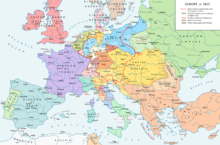
Back الوفاق الأوروبي Arabic Avropa Konserti Azerbaijani Европейски концерт Bulgarian Concert europeu Catalan کۆنسێرتی ئەورووپا CKB Koncert velmocí Czech Cytgord Ewrop Welsh Pentarchie (Europa) German Ευρωπαϊκή Συμφωνία Greek Eŭropa Koncerto Esperanto
| Concert of Europe | |||
|---|---|---|---|
| 1815 to 1848/1860s – 1871 to 1914 | |||
 The national boundaries within Europe as set by the Congress of Vienna, 1815 | |||
| Including | |||
Chronology
| |||
The Concert of Europe was a general agreement among the great powers of 19th-century Europe to maintain the European balance of power, political boundaries, and spheres of influence. Never a perfect unity and subject to disputes and jockeying for position and influence, the Concert was an extended period of relative peace and stability in Europe following the Wars of the French Revolution and the Napoleonic Wars which had consumed the continent since the 1790s. There is considerable scholarly dispute over the exact nature and duration of the Concert. Some scholars argue that it fell apart nearly as soon as it began in the 1820s when the great powers disagreed over the handling of liberal revolts in Italy, while others argue that it lasted until the outbreak of World War I and others for points in between.[1] For those arguing for a longer duration, there is generally agreement that the period after the Revolutions of 1848 and the Crimean War (1853–1856) represented a different phase with different dynamics than the earlier period.
The beginnings of the Concert of Europe, known as the Congress System or the Vienna System after the Congress of Vienna (1814–1815), was dominated by the five great powers of Europe: Austria, France, Prussia, Russia, and the United Kingdom. Initially envisioning regular Congresses among the great powers to resolve potential disputes, in practice, Congresses were held on an ad hoc basis and were generally successful in preventing or localizing conflicts. The more conservative members of the Concert of Europe, members of the Holy Alliance (Russia, Austria, and Prussia), used the system to oppose revolutionary and liberal movements and weaken the forces of nationalism. The formal Congress System fell apart in the 1820s but peace between the Great Powers continued and occasional meetings reminiscent of the Congresses continued to be held at times of crisis.
The Concert faced a major challenge in the Revolutions of 1848 which sought national independence, national unity, and liberal and democratic reforms. The 1848 Revolutions were ultimately checked without major territorial changes. However, the age of nationalism ultimately brought the first phase of the Concert to an end, as it was unable to prevent the wars leading to the Italian unification (by Piedmont-Sardinia) and German unification (by Prussia) in 1871 which remade the maps of Europe. Following German unification, German chancellor Otto von Bismarck sought to revive the Concert of Europe to protect Germany's gains and secure its leading role in European affairs. The revitalized Concert included Austria (at the time a part of Austria-Hungary), France, Italy, Russia, and Britain, with Germany as the driving continental power. The second phase oversaw a further period of relative peace and stability from the 1870s to 1914, and facilitated the growth of European colonial and imperial control in Africa and Asia without wars between the great powers.
The Concert of Europe certainly ended with the outbreak of World War I in 1914[2] when the Concert proved ultimately unable to handle the collapse of Ottoman power in the Balkans, hardening of the alliance system into two firm camps (the Triple Alliance and Triple Entente), and the feeling among many civilian and military leaders on both sides that a war was inevitable or even desirable.
- ^ Lascurettes, Kyle (2017). "The Concert of Europe and Great-Power Governance Today: What Can the Order of 19th-Century Europe Teach Policymakers About International Order in the 21st Century?". RAND Corporation. Retrieved 15 February 2022.
- ^ "U.S. Resident Officers Conference". 1950.
© MMXXIII Rich X Search. We shall prevail. All rights reserved. Rich X Search